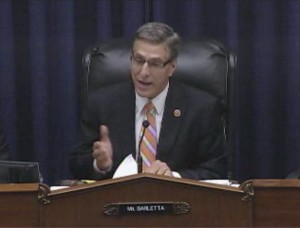 It has been almost two weeks since the Economic Development, Public Buildings and Emergency Management Subcommittee of the House Transportation and Infrastructure Committee convened its May 22nd hearing entitled “Saving Taxpayer Dollars: Freezing the Federal Real Estate Footprint”. I’m just now getting around to writing about this–a testament to how busy things have been for the Colliers Government Solutions team. The hearing provided a forum for grandstanding on a range of topics too extensive to be covered here. This post provides some of our key observations, with space downsizing as the consistent theme.
It has been almost two weeks since the Economic Development, Public Buildings and Emergency Management Subcommittee of the House Transportation and Infrastructure Committee convened its May 22nd hearing entitled “Saving Taxpayer Dollars: Freezing the Federal Real Estate Footprint”. I’m just now getting around to writing about this–a testament to how busy things have been for the Colliers Government Solutions team. The hearing provided a forum for grandstanding on a range of topics too extensive to be covered here. This post provides some of our key observations, with space downsizing as the consistent theme.
“We don’t want to miss this opportunity”
In his opening statement, Subcommittee Chairman Lou Barletta (R-PA) said that “both the President and Congress want to put more people in less space and save taxpayers money. We all know that doesn’t happen too often when Democrats, Republicans and the President all agree–and the American people want to see that. Republicans and Democrats agree on spending cuts, and how often does that happen?” He went on to note that huge numbers of GSA leases are expiring in the next three years and that “it’s a buyer’s market.” In his view, these expiring leases represent the perfect occasion to improve utilization and lower costs. He proclaimed “We don’t want to miss this opportunity.” This Congress wants to see real change happen immediately.
“Even though millions of square feet of leases are expiring soon, GSA has submitted zero lease prospectuses.”
This statement, also made by Barletta, should be a concern for landlords with large upcoming lease expirations. Congress’ recent record for approving prospectuses has been abysmal and Barletta appeared to acknowledge that fact while heaping much of the blame on GSA and the changing times. He noted that many of the prospectuses issued to the last Congress were based on workforce projections and utilization standards that predated the financial crisis. “In other words,” he said “they were not worth the paper they were written on…GSA took far too long to provide the Committee with updated information the Committee needed to authorize them.”
Indeed, we are facing a substantial volume of lease expirations, fueled in part by a surge in post-9/11 leasing 10 years ago. In the face of this, Barletta is already suggesting that the approval process will continue to be lengthy unless GSA’s prospectus lease proposals conform to the significant cost and space reductions demanded by the House. The catch is that these space reductions will often trigger costly renovations and difficult leasing decisions. If GSA and its tenant agencies aren’t up to the task we’ll continue to see more short-term renewals and more holdovers. It’s a miserable process to experience from the landlord’s perspective.
“Mr. Chairman, we need a Civilian BRAC process to help us address these challenges.
BRAC is back (Civilian BRAC, at least). At the start of this 113th Congress, Rep Jeff Denham (R-CA) re-introduced his Civilian BRAC bill, a legislative proposal that had support from the House last year. GSA’s head of the Public Buildings Service, Dr. Dorothy Robyn stated that GSA needs the Civilian BRAC process, indicating that GSA is abandoning any support for alternate methods for property disposition. More significantly, it suggests that Congress and the Executive branch are fully aligned as to the need for property dispositions and the method to do so. Therefore, it now seems quite likely that we will see this legislation passed and the sale of vacant and underutilized property should accelerate.
This has some indirect impact on the federal leased inventory that may be beneficial to lessors. The reason is that federal agencies will shift tenants from underutilized properties in order to dispose of them and, unless federal owned space is available to house these people, the government will seek leased space. Now, to be clear, this space will typically be characterized as short-term or “swing” space but we would not be surprised to see some long-term occupancies result anyway. The government’s ability to shift its people to owned space will depend heavily on GSA’s budget appropriations, which is a funding problem outlined below.
“A major obstacle to us achieving this vision more quickly is the need for upfront funding to reconfigure space”
Dr. Robyn stated that GSA needs funding from Congress to be able to realize the vision of improved space utilization. Her comments echoed those we reported on in our “It’s Really Expensive To Be Poor” article at the beginning of this year.
Though the Federal Buildings Fund provides revenue sufficient for repair and alterations of owned buildings, in each of the past three fiscal years Congress has approved obligational budget authority roughly $1 billion less than the revenue GSA receives each year through rent and other income. GSA needs this funding to renovate and reconfigure its owned buildings if it hopes to accommodate new federal tenants. So, if you are looking for one simple indicator to determine whether agencies will begin relocating from leased space, follow GSA’s budget.
This congressional hearing focused on a set of topics related to a similarly titled article we posted back in March. We encourage you to read it too.
